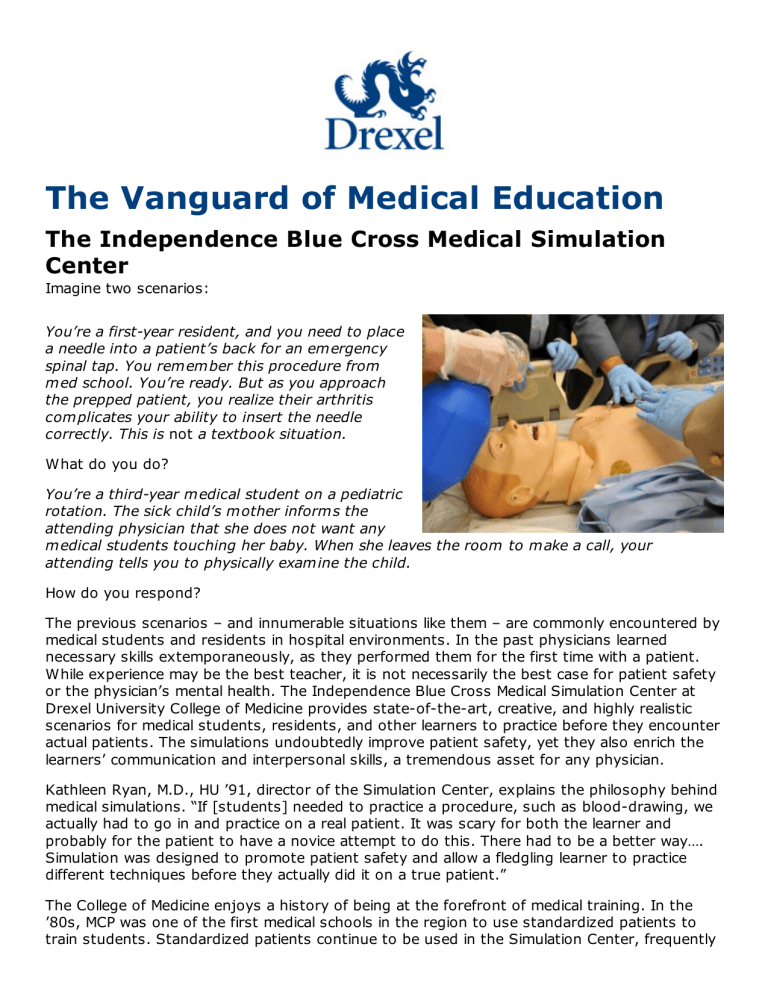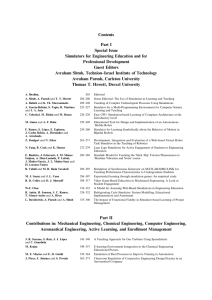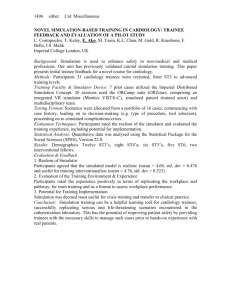The Vanguard of Medical Education The Independence Blue Cross Medical Simulation Center

The Vanguard of Medical Education
The Independence Blue Cross Medical Simulation
Center
Imagine two scenarios:
You’re a first-year resident, and you need to place a needle into a patient’s back for an emergency spinal tap. You remember this procedure from med school. You’re ready. But as you approach the prepped patient, you realize their arthritis complicates your ability to insert the needle
correctly. This is not a textbook situation.
What do you do?
You’re a third-year medical student on a pediatric rotation. The sick child’s mother informs the attending physician that she does not want any medical students touching her baby. When she leaves the room to make a call, your attending tells you to physically examine the child.
How do you respond?
The previous scenarios – and innumerable situations like them – are commonly encountered by medical students and residents in hospital environments. In the past physicians learned necessary skills extemporaneously, as they performed them for the first time with a patient.
While experience may be the best teacher, it is not necessarily the best case for patient safety or the physician’s mental health. The Independence Blue Cross Medical Simulation Center at
Drexel University College of Medicine provides state-of-the-art, creative, and highly realistic scenarios for medical students, residents, and other learners to practice before they encounter actual patients. The simulations undoubtedly improve patient safety, yet they also enrich the learners’ communication and interpersonal skills, a tremendous asset for any physician.
Kathleen Ryan, M.D., HU ’91, director of the Simulation Center, explains the philosophy behind medical simulations. “If [students] needed to practice a procedure, such as blood-drawing, we actually had to go in and practice on a real patient. It was scary for both the learner and probably for the patient to have a novice attempt to do this. There had to be a better way….
Simulation was designed to promote patient safety and allow a fledgling learner to practice different techniques before they actually did it on a true patient.”
The College of Medicine enjoys a history of being at the forefront of medical training. In the
’80s, MCP was one of the first medical schools in the region to use standardized patients to train students. Standardized patients continue to be used in the Simulation Center, frequently
in hybrid scenarios in which the student interviews the standardized patient for their history and then examines the simulator to detect symptoms.
The $9.3 million Simulation Center, housed in an expansion on the Queen Lane Campus, features several high-fidelity robot mannequins – the simulators – that can be programmed to run a variety of medical scenarios. The simulators exhibit vital signs and are programmed to respond accurately – as a real patient might – to the learners’ interventions. They respond to defibrillation and drug injections; their pupils dilate. A simulator can even cry out in pain, for example, if a student incorrectly inserts a needle. Each life-size robot costs approximately
$40,000-$80,000.
There are several adult-sized simulators, including a female, Noelle, who is equipped to give birth, as well as an infant and a newborn simulator. The Noelle simulator is programmed to measure the force of the delivering physician’s torque or pull. Ryan explains that students are taught to pull “hard enough” when delivering a baby, but that knowledge is more an art than a science. Pulling too hard can lead to neurological problems in the infant. This simulator lets the students know precisely how much force they’re exerting in a delivery.
The simulators are covered in a tissue that evokes skin but is able to withstand thousands of injections – and ultrasound – without corroding. They can be manipulated to be as lifelike as possible. For instance, Dr. Ryan mentions that in the scenario of an opiate overdose, the simulator’s arms are covered with tattoo sleeves.
Although much smaller than the “adult” simulator, the infant is likewise programmed to be as realistic as possible. APGAR scores can be measured, and its abnormal shrieks and grunts help learners distinguish a normal, healthy cry from something more ominous. It can be programmed to develop cardiac or respiratory distress and the learner must intervene appropriately to correct the situation. Medications can be delivered into the leg bone just as if it was a living baby.
There are also “task-trainer” simulators, particular body parts used to practice specific procedures. There is a torso, for example, used to practice inserting central lines. For spinal taps a block encasing the spine can be removed and replaced by another to simulate an obese or elderly patient, or one with severe arthritis. For those practicing injections into a joint, the simulator will buzz when the needle is inserted correctly.
Instructors want students “to get not only to a proficiency level where they are able to do the task with the least complication to the patient, but also where we can make sure their sterile technique is being done properly. This will cut down on the potential infection rate in hospitals,” states Ryan.
The Simulation Center itself is comprised of a suite of rooms, including a control center, exam rooms, and debriefing rooms. The control center is “the magic behind the scenes.” It is where
Ryan, the course instructor, and other facilitators both administer the lesson and monitor student actions. For example, if the student is performing a physical on a simulator, the administrator in the control room can speak into a microphone, and the voice comes from the simulator in real time. The administrator can also change other aspects of the “patient,” such as heart rate or breathing patterns, as the lesson requires.
The exam rooms are set up like hospital rooms. They are designed to mirror as closely as possible what a learner will encounter in a hospital – even down to how the drugs are arranged in the code cart. The exam rooms can also be modified to suit the instructor’s needs, such as including more traditional classroom features, like a whiteboard. Every exam room is equipped with unobtrusive cameras and wired for sound.
Once a particular scenario or lesson is finished, learners enter a debriefing room equipped with video, sound, and whiteboard. The system in the simulation center records and integrates the various data, so as students watch and listen to the scenario in which they just participated, the simulator’s vital signs are simultaneously displayed, as are the measurable metrics of a student’s intervention. This means that, in the case of a cardiac arrest, they can see not only the patient’s heart rate, but also the depth of their own compressions. Reviewing the recent scenario
“allows the student to have immediate feedback, which is critically important in their formative development,” Ryan says.
She goes on to explain exactly why this reflection is so critical, revealing that reviewing the video “is really a very powerful tool. What’s happening in a minute, you sometimes don’t really realize until you step back later and review it. We’ve had upper-level trainers – and because they were each doing a different job instead of the job they were supposed to do, nobody was giving the patient oxygen for two minutes. So we were able to actually look at that and teach them why it’s important, when you’re working as a team, that the members do the job assigned.” Examining the scenario allows for a multitude of valuable “teachable moments.”
The Simulation Center programs are incorporated into the overall medical school curriculum.
Ryan provides the example of “heart failure” to illustrate how each year’s group might approach a situation. For first-year students, “heart failure” means experiencing its physiology.
For second years, it means practicing physical exam skills. Third- and fourth-year students might encounter rare conditions and practice upper-level skills such as “differential diagnosis skills” and “team dynamics.”
Simulation can be used to experience emotionally charged situations. Ryan explains that they will introduce the upper-level students to a cardiac arrest scenario in which they are unsuccessful. “We don’t let them bring the simulator back to life. So now they have a patient that died. The purpose of the simulation is to have them go into the next room and explain what happened to the family member. It allows them to develop upper-level skills such as delivering bad news…learning how to handle medical error or medical mistakes – learning how to minimize medical error and medical mistakes.” In some of these scenarios, a confederate, or actor, will portray the grieving family member.
Dr. Ryan reveals that the various scenarios are extremely realistic and can evoke authentic emotional responses from students. For this reason, first- and second-year students “are not allowed to kill the simulator.” Ryan cautions that real grief responses can begin, and young students may consider leaving medical school. Similarly, alumni using the facility have had old and painful memories triggered by some of the scenarios. This trauma is quite real. Ryan stresses that learner support is of the utmost importance. For this reason a psychologist, as well as other trained first-responders, are Simulation Center resources.
Particularly since the scenarios can trigger such strong emotions, there is a real sensitivity to the learners’ privacy and safety. Likewise, the scenarios present situations where students will make mistakes. They are expected to make mistakes. The Simulation Center needs to be considered a safe environment where this type of learning can happen. Ryan is serious when she says they “play by Vegas rules,” in that what happens there stays there. The protective silence has also created what she calls a “Bermuda Triangle” aspect to the Simulation Center.
The students respect the code so well that incoming learners aren’t sure what to expect from each situation; information about content rarely trickles out to the younger students. Ryan
reveals that much of the student feedback consists of “I wish I did my reading” in terms of preparing better for the simulation. They start to realize that real life is more than multiple choice questions where the answer is somewhere on the paper.
The center, which opened in December 2009, will be up for certification after it has been open two years. As the Simulation Center moves ahead, it will continue to get its own capacity situated. Affiliate sites send their residents for training, and there is the possibility of integrating the center with a physician refresher course. In the future, the center also may be rented to outside hospitals and residents as an educational resource.
Learners and faculty have been very enthusiastic about the Simulation Center. Ryan states that their response “[has] been overwhelmingly positive across the board.” In fact, last year’s fourth-year students did not have a great opportunity to rotate through, and they clearly lamented that they didn’t get to use the center as much as the other students. “I’ve never had trouble recruiting faculty for the Simulation
Center, especially once they’ve been here once.
They love doing it…. It’s real world, but without the super pressure,” she says.
The outcomes for the learners are instantly clear Sim man and students as well. “Simulators are never meant to replace real patients,” Ryan explains. “They’re meant to give the students the ability to practice some skills so that when they do interface with a real patient their anxiety level is lower and both the student and the patient are getting a much more rich experience from each other…. It’s amazing the difference that one simulation makes.”
As one enters the suite for the center, a poster of DaVinci’s Vitruvian Man is prominently displayed. The Vitruvian Man was the Renaissance’s answer to cutting-edge anatomical knowledge and medical technology. DaVinci’s ink and paper drawing is juxtaposed with the high-fidelity, lifelike robots the medical students and other learners will encounter just down the hall. The pedagogic work being accomplished at the center highlights this dynamic synthesis of art, science, medicine, and technology. And the learners are all the better for it.
© Copyright 2013 - Drexel - All Rights Reserved.


